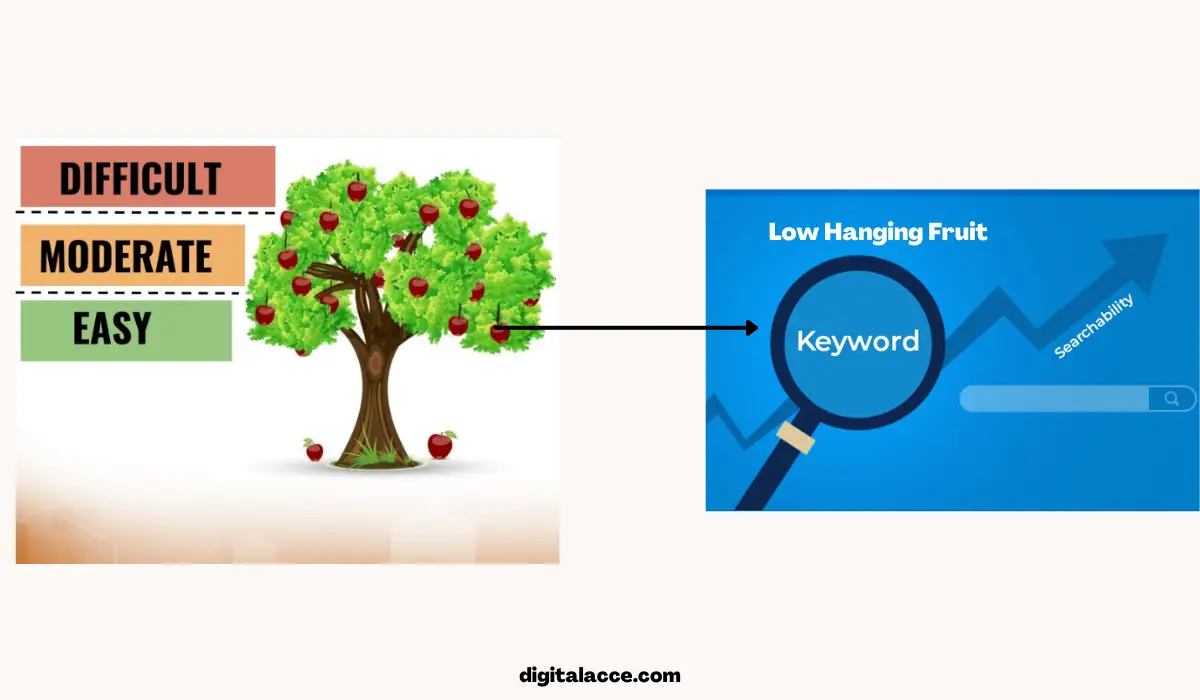In the vast landscape of search engine optimization (SEO), finding the right keywords to target can make all the difference in the success of your online presence. While high-competition keywords may seem enticing, they often require substantial time and resources to rank for. That’s where low hanging fruit keywords come into play. These are the keywords that offer a higher chance of ranking well with less effort and competition. In this article, I will explain the strategies and techniques on how to find low hanging fruit keywords.
By identifying and targeting these keywords, you can optimize your website’s visibility, attract relevant traffic, and achieve tangible results. So, let’s dive in and discover the secrets to unlocking these valuable keywords that are ripe for the picking!
Contents
Keyword Research Overview
Keyword research is a fundamental aspect of search engine optimization (SEO) that involves identifying the terms and phrases people use when searching for information, products, or services online. It plays a crucial role in driving targeted organic traffic to your website.
By conducting thorough keyword research, you can gain insights into user behaviour, understand the language they use, and align your website content with their needs.
By strategically incorporating these keywords into your content, meta tags, and other SEO elements, you increase the chances of ranking higher in search engine rankings and attracting organic traffic.
10 Proven Strategies: How To Find Low Hanging Fruit Keywords
a. Choose SEO Tools to Use
Selecting the right SEO tools is indeed a crucial first step in discovering low hanging fruit keywords. These tools provide valuable insights and data that help you make informed decisions about your keyword targeting.
Every other strategy discussed here revolves around using one or two tools to execute.
You could check my comprehensive list of free SEO tools that could help your business.
b. Utilizing Long-Tail Keywords
Long-tail keywords are specific keyword phrases that typically consist of three or more words. Unlike broad, general keywords, long-tail keywords are more specific and often reflect a user’s specific search intent.
For example, while a broad keyword might be “shoes,” a long-tail keyword could be “women’s running shoes with arch support.”
Advantages of Long-Tail Keywords
The advantages of using long-tail keywords are significant:
- Lower competition: Long-tail keywords generally have lower competition compared to broader keywords. This means you have a higher chance of ranking well in search results and attracting targeted traffic to your website.
- Higher conversion potential: Long-tail keywords often indicate a more specific search intent, showing that users are looking for something particular. This specificity increases the chances of attracting visitors who are further along the buyer’s journey and more likely to convert into customers or take desired actions.
- Improved relevance: By targeting long-tail keywords, you can tailor your content to match the exact needs and interests of your audience. This improves the relevance of your website, leading to higher engagement, lower bounce rates, and better overall user experience.
c. Analyze Search Volume & Competition
Search volume is a quantitative measure that provides valuable insights into keyword popularity and audience potential.
For example, let’s consider two keywords related to a fitness website: “best workout routines” and “best workout routines for beginners.”
When analyzing search volume using tools like Google Keyword Planner, you might find that “best workout routines” has a high search volume of 10,000 searches per month. This indicates a large potential audience interested in finding workout routines.
However, it’s important to note that high search volume also signifies intense competition among websites trying to rank for that keyword.
On the other hand, “best workout routines for beginners” might have a lower search volume of 1,000 searches per month. Although the search volume is lower, it indicates a specific target audience looking for beginner-friendly workout routines. This keyword may have less competition compared to the broader keyword, making it easier to rank well and attract relevant traffic.
To strike a balance, you could target the keyword “best workout routines for beginners” to optimize your website for a specific audience segment.
While the search volume is lower than the broader keyword, it still provides a reasonable amount of potential traffic. By focusing on this long-tail keyword, you can tailor your content to meet the needs of beginners and position yourself as an expert in that niche.
d. Identify User Intent
Understanding user intent is crucial for effective keyword optimization and creating content that aligns with the needs of your target audience. User intent refers to the underlying motivation or purpose behind a user’s search query.
By understanding user intent, you can tailor your keyword targeting and content strategy to provide the most relevant and valuable information, products, or services to your audience.
When you optimize your website for keywords that match user intent, you increase the chances of attracting the right audience and driving engagement, conversions, and overall user satisfaction.
By aligning your content with user intent, you not only improve your search engine rankings but also enhance the user experience, resulting in higher click-through rates, longer session durations, and better overall website performance.
Categorization or Types of User Intent
User intent can be broadly categorized into three main types of queries: informational, navigational, and transactional.
1. Informational queries
These queries reflect users seeking information or answers to their questions. Examples include “How to lose weight,” “Benefits of yoga,” or “Best budget-friendly Smartphones.” Users with informational queries are looking for educational content, guides, tips, or explanations.
2. Navigational queries
Navigational queries occur when users are searching for a specific website or brand. Examples include queries like “Facebook login,” “Nike official website,” or “YouTube tutorials.” Users with navigational queries have a specific destination in mind and are looking for a particular website or online resource.
3. Transactional queries
Transactional queries indicate users who are ready to make a purchase or take a specific action. Examples include queries like “buy iPhone X online,” “discounted hotel deals,” or “book flight to London.” Users with transactional queries clearly intend to engage in a commercial transaction or perform a specific action.
e. Leveraging Niche and Local Keywords
When it comes to keyword optimization, leveraging niche-specific and local keywords can be highly beneficial, depending on the nature of your business.
Niche-specific keywords are highly relevant terms that specifically cater to your industry, products, or services. By targeting these keywords, you can attract a more focused and interested audience.
For example, instead of targeting broad keywords like “skincare products,” you can leverage niche-specific keywords like “organic vegan face moisturizer” or “cruelty-free natural body scrub.” This focused approach increases the chances of driving qualified traffic and converting them into customers.
For businesses that operate in specific locations, targeting local keywords is crucial to attracting customers in the vicinity. Local keywords include location-based terms such as city names, neighbourhoods, or other geographical identifiers.
f. Analyze Competitor Keywords
By understanding the keywords your competitors are targeting, you can gain a competitive edge and find low hanging fruit keywords that may be overlooked.
Suppose you run an online fitness store, and one of your main competitors is “Fit4Life Supplements.” By visiting their website and analyzing their content, you notice that they heavily target keywords like “best protein supplements,” “natural weight loss products,” and “organic workout supplements.”
This indicates their focus on health-conscious customers and suggests potential low hanging fruit keywords related to specific product types or niche audiences.
Using a keyword research tool, you discover that Fit4Life Supplements is ranking well for “vegan protein powder with no artificial sweeteners” and “gluten-free weight loss supplements.” These are examples of low hanging fruit keywords that you can target to attract a more targeted audience looking for specialized products.
How To Analyze Competitors and Their Keyword Strategies
To effectively analyze your competitors’ keyword strategies and find low hanging fruit keywords, follow these practical steps:
- Identify your main competitors: Start by identifying your primary competitors within your industry or niche. These are the businesses or websites that are targeting a similar audience or offering similar products/services.
- Analyze their website content: Visit your competitors’ websites and carefully examine their content, including blog posts, product descriptions, and landing pages. Look for recurring keywords or phrases they are targeting. Pay attention to titles, headings, and meta tags.
- Utilize keyword research tools: Use keyword research tools like SEMrush, Ahrefs, or Moz to gain insights into the keywords your competitors are ranking for. These tools can provide data on organic keyword rankings, search volume, and competition levels.
- Study competitor backlinks: Backlinks play a significant role in SEO. Analyze the backlink profiles of your competitors to identify the websites linking to their content. This can help you discover additional keywords and content ideas that have worked well for them.
- Explore their social media presence: Investigate your competitors’ social media accounts and observe the keywords they use in their posts, hashtags, and captions. This can provide further insights into their keyword-targeting strategies.
g. Refine and Re-evaluate Keywords
To ensure your keyword selection is focused and effective, it’s crucial to filter and refine your keyword lists.
For example, if you run a travel blog, you may initially have a broad keyword like “best travel destinations.” Refining this keyword could involve narrowing it down to “off-the-beaten-path travel destinations” or “budget-friendly travel destinations,” which are more specific and potentially less competitive.
In addition, considering search trends and seasonality is crucial to optimize your keyword strategy effectively.
For example, if you own a gardening website, you may discover that the search term “spring gardening tips” experiences a significant spike in search volume during the spring season. By optimizing your content around this keyword during the appropriate season, you can attract more targeted traffic and potentially rank higher.
Regularly monitoring and evaluating keyword performance is essential to optimize your SEO efforts.
Suppose you’re targeting the keyword “best hiking trails.” By tracking the rankings and analyzing website analytics, you notice that the keyword “top hiking trails near [your location]” is driving more organic traffic and conversions.
This indicates that the localized version of the keyword may be a low hanging fruit keyword that aligns better with your target audience’s search intent.
Conclusion
In conclusion, discovering low hanging fruit keywords is a valuable approach to improve your website’s visibility and attract targeted traffic.
Using the right tools and strategies, you can optimize your keyword targeting and achieve better results. Start implementing these techniques to find low hanging fruit keywords and enhance your SEO efforts.


